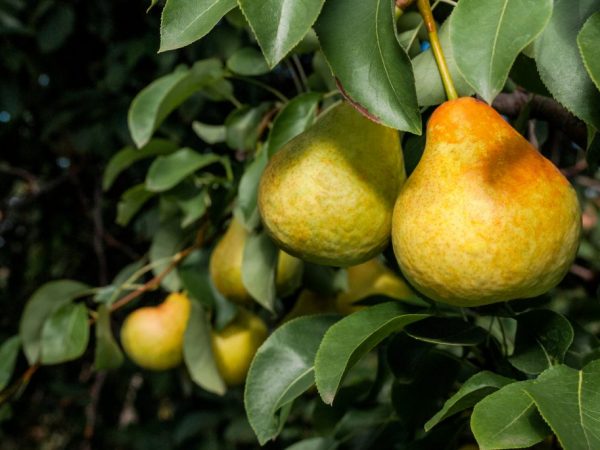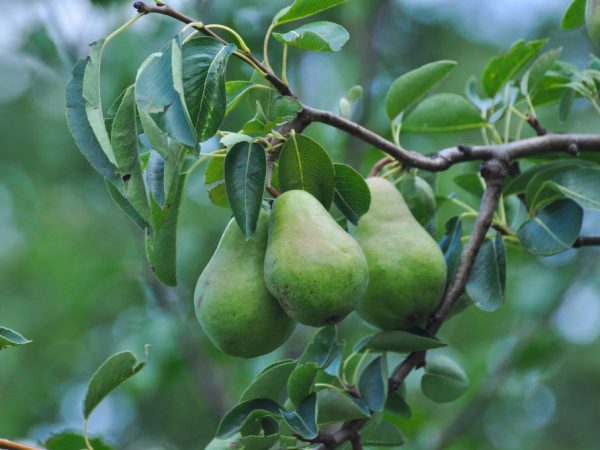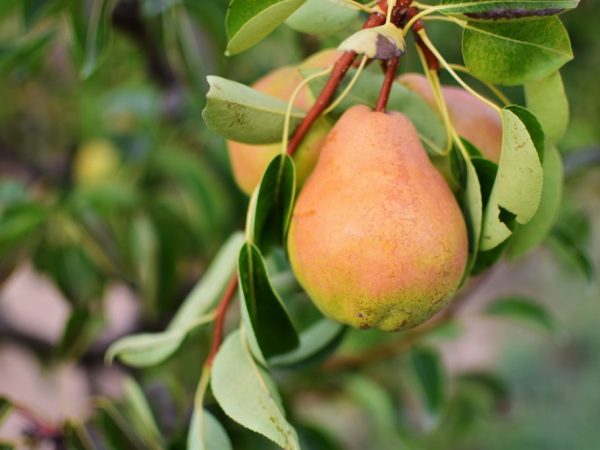Description of the variety of pears Marble
Over the past several decades, breeders have bred a large number of varieties of pear trees. About 200 varieties are grown on the territory of the Russian Federation. One of the most popular is the marble pear. It attracts gardeners with its crown, tasty fruits and high yield characteristics.

Description of the variety of pears Marble
Characteristic
The Marble pear variety was bred as a result of crossing the Winter Michurina and Krasavitsa Lesa varieties.
In 1965, the Marble pear variety was entered into the State Register of the Russian Federation. It is suitable for cultivation in all regions of the country, but is most often found in the south.
Plant features
The height of the tree is about 4 m. The crown of medium density is presented in a wide-pyramidal form. Most of the bark on the main trunk and trunk is dark gray. On the side shoots, brown is found. Fruit formation occurs on the ringlets.
According to the description, the leaves are of medium size, dark green. The buds are presented in the shape of a triangle and have a brown tint. The sheet plate is smooth and glossy in structure. The inflorescences include a large number of pale pink flowers. The flower size is 3-5 cm. Up to 9 flowers are formed in one bud.
Fruit appearance
The size of the Marble pear is slightly above average. Most often there are fruits 10-13 cm long and weighing 200 g. The shape of the fruit is conical.
The peel is dense, contains a small amount of small spots. The main color is rich yellow. In the period of full ripening, the fruits acquire a marbled pink blush. According to the description, the Marble pear variety contains a small amount of small brown seeds.
The taste is rich, sweet. The sugar level is 15-17%. These fruits contain a large amount of vitamins C and B, so they have a positive effect on human health and immune system.
Pollination possibility
Fruiting occurs 6 years after planting, in the middle of summer. In order for the yield to be high, mandatory pollination is necessary. It is believed that the marble pear belongs to partially self-pollinated crops, i.e. she can independently act as a pollinator.
It can be grown near other, related pear varieties. Ideal pollinators for her are the Chizhovskaya, Lada or Duchess variety. They are characterized by disease resistance and high fruiting characteristics.
Planting

You need to find a good place for the pear
Before you start planting, you need to determine the right place for planting and choose the optimal seedling. It is also important to choose the ideal soil or prepare it in advance.
Sapling selection
When choosing a seedling, pay attention to its characteristics:
- Age must not exceed 2 years. Elderly seedlings are inhibited in development.It is difficult to dig them up for transfer to a new place: there is a possibility of damage to the root system.
- The roots should be correctly and evenly spaced in relation to each other. They should not be damaged in any way. The maximum number of main roots should be no more than 5. The length of the roots should not exceed 30 cm.
- The bark should not show any signs of damage or infestation.
Boarding time
This variety is planted both in spring and autumn. Spring planting is carried out only after the risk of frost has disappeared: Marble pear does not tolerate low temperatures. The ideal time for planting in spring is early May.
In autumn, trees are planted in October: this way the plant will have time to start before the onset of frost.
Planting place
A pear is a plant that loves a lot of moisture, heat and light, so they choose areas where the sun's rays fall. If you install a wind barrier at a distance of 3.5 m from the plant, this will increase yields.
The soil should be nutritious, with a high content of black soil and sand. It should be loose. You should not plant pear trees in clayey areas: fruiting is worse on them.
Landing rules

The development of the tree depends on the correct planting.
To begin with, dig a hole 80 cm wide and 100 cm deep. After that, organic matter is introduced into it in the form of compost or humus. After a few weeks, the seedling is lowered into the pit. The root bud should be located at a height of 4 cm from the ground, it must not be buried: this leads to the death of the roots.
Near the hole, at a distance of 2 cm, a support in the form of a peg is driven in. This is necessary for tying up the plant, which allows it to develop correctly. The root system is evenly distributed over the entire section of the hole and gradually covered with earth. The soil should fill the areas between the roots. After the pit is filled, the earth is tamped and watered with 2 buckets of water.
Care rules
Leaving is the most important stage, it is on it that the development of the plant and the result of yield depend.
It is important to water on time: the development of the plant and the formation of fruits depend on it. If the moisture level in the soil is insufficient, it will lead to low fruiting. Watering is carried out in the morning or evening, but only with warm water. The regularity of watering is once a week. Each plant should have 2 buckets of water.
Maintenance does not consist of watering alone; it is important to regularly feed the crop. It is imperative to carry out high-quality fertilizers. Top dressing is applied according to a certain mode. The first feeding using humus is applied during flowering. The second is during the period of fruit formation. It involves the use of phosphorus-potassium compounds and will allow the fruit to grow in size and acquire an even richer taste. The third subcortex is carried out during the period of active fruiting. At this point, it is better to use peat or compost: this will allow the tree to absorb nutrients for the winter.
Damaged, dry or diseased branches are removed in a timely manner. Also, once a week, loosening of the soil and removal of weeds are carried out.
Fight disease
If signs of scab occur, spraying with 1% Bordeaux liquid is carried out. When exposed to powdery mildew, treatment is carried out with a 4% solution of copper sulfate. Only preventive spraying with Bordeaux liquid saves from fruit rot.
From pests, ticks, moths, sucker and rodents are isolated. Colloidal salt will help get rid of ticks. The moth will disappear if the plant is treated with a solution of garlic. They get rid of the honeydew by spraying the entire bush with calendula or chamomile tinctures. To protect the crop from rodents, use a special net, which is sold in agricultural stores.
Conclusion
Pear grade Marble - an option for beginner gardeners.It is able to provide a harvest in the amount that all gardeners dream of, because about 70 kg of products are harvested from 1 tree with proper care.

